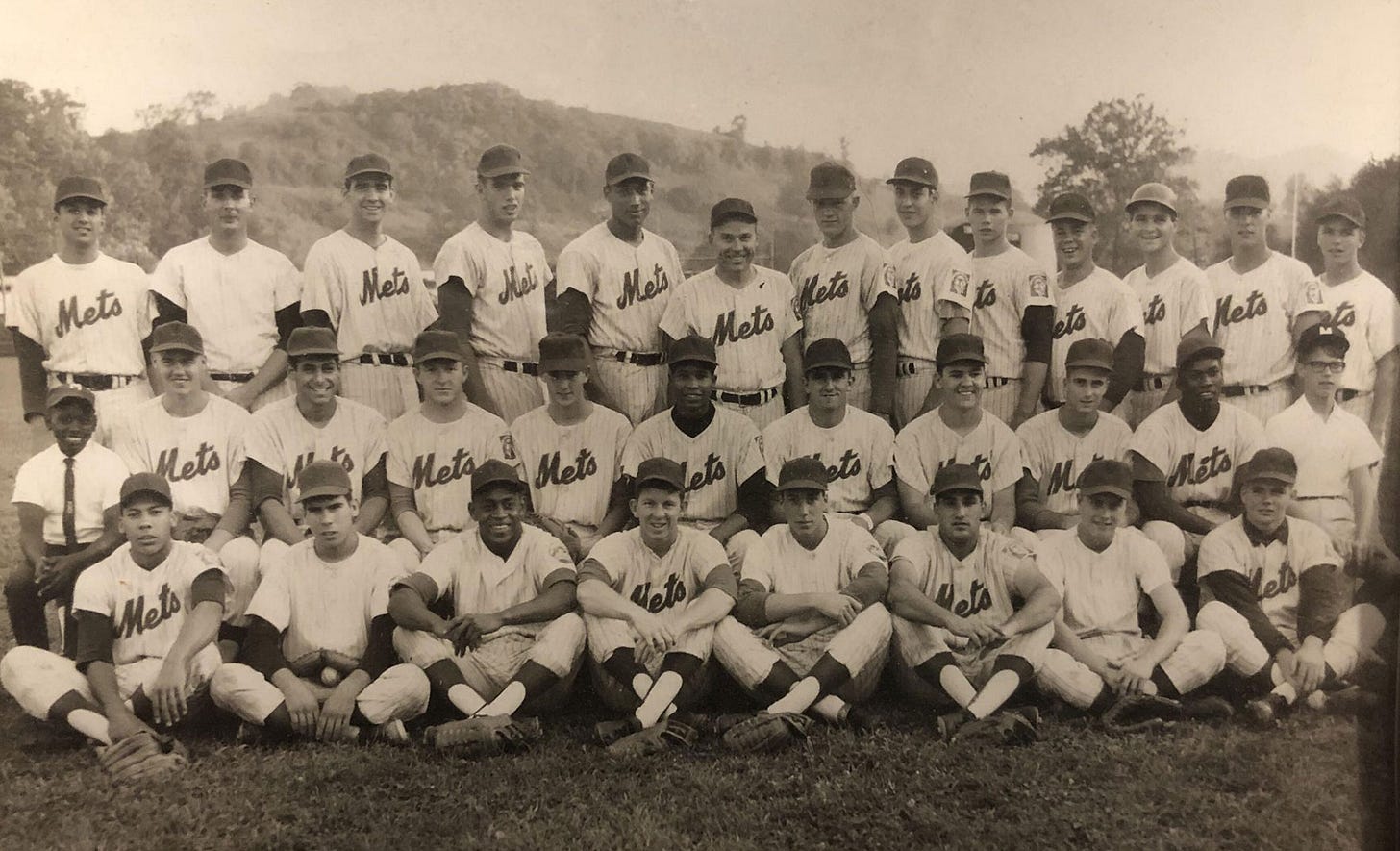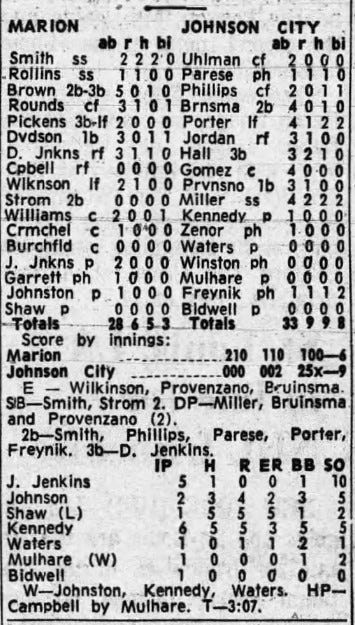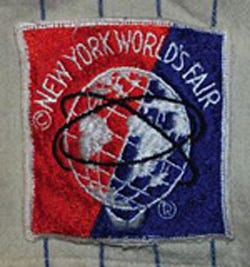A brief story of the Marion Mets’ first games
Plus, the 1965 team photo and a heartbreaking phone call
Marion Mets Newsletter – Issue 16
It was happening. It was finally happening.
After years of pleading their case to league officials, Marion, Virginia, in the summer of 1965, was getting a minor league baseball team to call its own.
“Mets Will Operate Farm Club Here,” read the bold, front-page headline in the May, 6, edition of the Smyth County News.
But, before umpires could yell “play ball” at Marion Stadium, lots of work had to be done. For example, the field had to be re-sodded and a ditch along the third base line had to be filled once the high school baseball season concluded. Volunteer workers, eager to see professional ballplayers roaming the Marion field, took care of both.

But that wasn’t all. The team’s parent organization in the Big Apple, the New York Mets, mandated water fountains be installed in the dugouts. Workers quickly checked that task off their list, too.
The more work that was needed, the more people around town chipped in. Some donated dirt for the infield – yep, dirt! – and equipment.
The Marion baseball club, however, had to purchase its own batting cage at the price of $275. It was delivered in pieces. Some parts got to the ballpark in a timely manner. Others got lost along the way, but eventually found their way to town.
The Appalachian League, where the Marion Mets would compete, insisted that 500 season tickets be sold. Fans could purchase a 30-pack of tickets for 10 bucks. Sales were fast in the beginning, slumped for a while, but eventually exceeded expectations, providing more funds for the local ball team.
Finances also got a boost from the Jaycees agreeing to pay $500 for the opportunity to operate the ballpark concession stands.
As for the players, Marion Baseball Club, Inc., made accommodations for the young athletes – many were 18-19 years old – to stay at Hotel Lincoln on Main Street until they could find a place of their own to rent during the two-and-a-half-month-long season. Initially, about 50 players were expected to arrive, most of whom had already spent a few weeks training in the Florida sunshine.
A manager was hired. His name was Pete Pavlck, a former ballplayer, scout and construction worker from Hackensack, New Jersey.
The team set home game start times for 7:45 p.m. – that was for single games – and 6 p.m. for doubleheaders. The first pitch on Sundays would be thrown at 4 p.m.
Admission would cost adults 50 cents, 25 cents for kids 12 and younger.
The full Appalachian League schedule, featuring Marion for the first time in a full season, was announced to the public weeks before play began.The Marion Mets – that name had a nice alliterative ring to it, didn’t it? – would open the season against the Yankees in Johnson City, Tennessee. Players would be staying in the John Sevier Hotel there for the duration of the scheduled two-game series.
Many folks from Marion, ecstatic about their new team, were expected to make the 90-minute road trip.
Everything, it seemed, was moving along according to plans.
There was one thing, however, all the planning in the world could not guarantee as the Mets were set to play the first game of their inaugural season on July 24, 1965, in the mountains of East Tennessee.
Rain!
*****
Jupiter Pluvius – now, there’s an ancient term – ruined the opening night for everyone.
The Yankees organization planned for a fun evening at the ballpark, beginning with pre-game festivities that included Miss Johnson City, Donna Rose, throwing out the ceremonial first pitch. The city’s mayor would be there. So would Appalachian League President Chauncey DeVault. A few former big league ballplayers, such as Tessesseans Jim Mooney and Clyde “Hardrock” Shoun, were scheduled to attend. Another former major league player, Eddie Stanky, would be there representing Marion as New York Mets director of player development.
Alas, on an unseasonably cool day, a half-inch of rain fell on the East Tennessee city and pushed the festivities – and the ballgame – back a night.
Not much changed in the plans except for the date on the calendar. After Rose tossed out the first pitch while wearing a pinstripe jacket, the game and the very first Marion Mets baseball game was underway.
The Mets gave their traveling fans reason for optimism. Marion jumped out to a quick 2-0 lead in the first inning. It was 3-0 after two innings, and 5-0 in Marion’s favor after five innings.
Lefty Jim Jenkins started on the mound for Marion, and pitched “like a house afire for five frames,” the Smyth County News’ Howard Imboden wrote. The 5-10, 170-pound Washington, D.C., native, struck out 10 Yankees and allowed only one hit in five shutout innings.
Marion’s relievers, however, gave it all away. Johnson City scored two runs in the bottom of the sixth, two more in the seventh and tacked on five runs - FIVE! – in the eighth for a 9-6 win in a contest that lasted three hours and seven minutes.
*****
Less than 24 hours later, the loss was already a distant memory and the Mets were back in Marion, ready to play for the first time in front of a home crowd that had been clamoring for a hometown baseball team for years.
More than 1,200 people showed up on a Saturday night – “far beyond hopes,” the Smyth County News reported – in a ballpark that provided seats for about 700. DeVault, the league president, was among them. Stanky was there, too. The Mobile, Alabama, native who had played professionally in Boston, Brooklyn, New York, Chicago and St. Louis, said he felt right at home in Marion.
When fans arrived, they found a ballpark that “had taken on new life,” Imboden wrote in the newspaper, since the end of the high school baseball season. Weeds and grass had been cut. Fresh ads for local businesses had been placed on the left field wall, and the P.A. system had gotten a makeover. A member of the New York Mets grounds crew came to Marion to build the pitcher’s mound.
Players from all over the country – from California to Indiana to New York to Maryland to Alabama – donned the blue, orange and white Marion’s Mets uniforms. Some of them were married, but many of the young ballplayers were still single. “Girls,” Imboden wrote, “get your pencils, we have everything,” blonde and brunette.
Just before the game began against the Harlan (Kentucky) Red Sox that Saturday night, before the frenzied fans could finally root on the home team, there was one more formality:
The ceremonial first pitch
David Graham had the honors after doing “the most work,” the Smyth County News said, “getting the field in shape.”
Despite this being the first ever home contest for the Marion Mets, there wasn’t much reporting on that particular game. We know Jim McAndrew – the right hander who later played seven seasons in majors, started and pitched four innings for Marion. Charles Garrett pitched in relief.
The Smyth County News, a weekly newspaper back then that had to fit a whole week’s worth of game coverage into a limited space, reported that the contest “was a terrific thriller and kept the opening night crowd glued to the grandstand and hillside far into the night.”
When it was finally over, after 11 innings, the Marion Mets had claimed a 6-5 victory over those Harlan Red Sox.
An abbreviated box score in the Johnson City Press reveals Harlan got on the scoreboard first with two runs in the top of the fourth. Marion cut the deficit to 2-1 with a tally in the bottom of the sixth. Harlan increased its lead to 5-1 in the top of the seventh.
It was a bleak beginning for the home team until the Mets staged a late-game rally, scoring two runs in the bottom of the seventh and two more in the bottom of the ninth to tie the game at 5-5.
Neither team scored in the 10th, but in the bottom of the 11th inning, Marion somehow, someway, pushed the game-winning run across the plate. Was it a walk-off home run? Did a Mets score on an error?
Who knows?
I’ve searched through countless newspapers, and so far, I’ve found nothing telling us how the Mets won in such nail-biting fashion. I’ll keep searching.
The Marion Mets played well in that inaugural 1965 season and stayed in the league race much of the way before fading in August. Much of that fade can be attributed to players like McAndrew getting the call to move up a rung on the minor league ladder.
Marion finished the season with a 37-33 record and brought nearly 30,000 fans to tiny Marion Stadium during the short season, from mind-June to the end of August. That number was an affirmation to what many had been saying all along in an attempt to lure a team to the Southwest Virginia town.
“Marion looks like a good baseball town,” Stanky said as the field was being re-sodded and new paint was applied to the ballpark days before play began. “We think this is going to be an excellent operation.”
About that team photo
Let’s take another look at the 1965 Marion Mets team photo. There’s a lot we can talk about there, but I just wanted to point out a couple of things today. First of all, we know this photo was taken no sooner than the first week of July because Nolan Ryan – the most famous Marion Met alum – is there. “Nolan is on the middle row,” Sherry Clawson, Ryan’s former assistant, told me by email in December 2021. “Starting from the left with the batboy, Nolan is the fifth person.” Ryan joined the Marion Mets, around July 8, 1965.
Second, take a look at the player to the left of Ryan – your left, not his – and four players on the top row, to the right. See those shoulder patches? We know the Marion Mets often wore hand-me-downs uniforms from their parent organization, the New York Mets. In 1964 and ‘65, the big league Mets wore a patch on their left sleeves to commemorate the World’s Fair taking place, mostly in the summer, of those two seasons. So, were some of the rookie league Mets sporting the New York World’s Fair patch on their jerseys in Marion? The answer is “Yes,” said sports uniform expert Paul Lukas, the creator of UniWatch. “That is definitely the World’s Fair patch being worn by the [Marion] players.”
According to the Baseball Hall of Fame’s Dressed to the Nines website, the New York Mets added numbers to the fronts of their jerseys in ‘65. So, it’s most likely these ‘65 Marion jerseys with the World’s Fair patches were worn in New York during the ‘64 season.
As I mentioned at the top, there’s a lot that can be discussed about the ‘65 team photo. Who, or what, do you see in the picture? Let me know at chadoz97@gmail.com.
A heartbreaking phone call
Researching and writing this Marion Mets newsletter is blast. Sure, it can be time-consuming and challenging, but overall, it’s a lot of fun. A lot of fun!
I’ve met and talked with many interesting people who have shared with me their stories about the Mets, some of whom played in Marion and others who went to games as a kid with their fathers.
Sometimes the biggest thrill of this project can come from finally reaching a source by phone after months of searching for the correct phone number. Often when I call, I get the “this number is no longer in service” message. Rarely will someone tell me they’re not interested in talking. Twice, I accidentally called a perky cat-groomer. Twice! She was very understanding about my repeated mistake.
A couple of weeks ago, however, I made a call that will stick with me for a while. I called the number for a former Marion player – I won’t mention his name out of privacy – and his wife answered. “I’m so sorry,” she said, “but he is very sick.” If he recovers, she explained with doubt in her voice, “he probably won’t be able to help you. The sickness she said, “has taken his mind.”
I felt terrible and apologized for calling.
She calmly spoke for a few more minutes about their time together. “I’ve been with him for 46 years,” she said.
I apologized more.
Honestly, I didn’t know what to say. I just thanked her for her time and wished her and her husband the best. She thanked me for calling, and as she said goodbye, her once-steady voice now quivering, she broke into tears. She hung up, and I just held the phone to my ear listening to the silence, feeling terrible about upsetting this woman. I felt like crying myself.
I often tell people this project isn’t so much about baseball as it is about the people who were impacted, in one way or another, by the teams that played in Marion. This phone conversation with a former player’s wife was a heartbreaking reminder of the human side of it all.
Before you go, this is my regular reminder that I’m always looking for stories about the Marion Mets. If you were a player, fan, ball boy, concession stand worker… anything… and have a story to share, I’d love to talk with you. You can reach me at chadoz97@gmail.com. Also, if you see something I missed or simply got wrong, send me a note.
There are some of you who have reached out, and I haven’t had time to get back with you. I promise I will soon.
And don’t forget to Connect with Marion Mets on Facebook.






